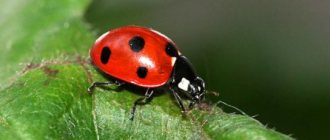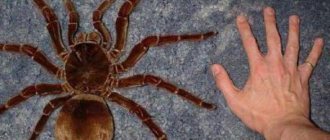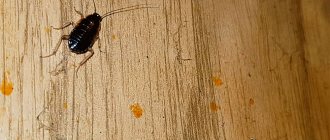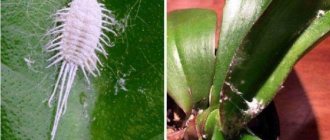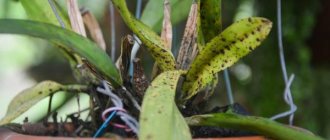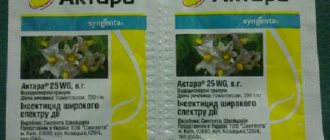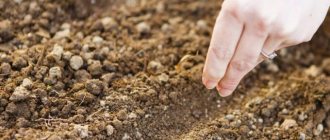Shields
It is very easy to determine that your orchid has scale insects: tubercles and growths visible to the naked eye appear on the plant, under which these pests live in the adult stage. At this time, mobile larvae actively spread to neighboring plants.
It is extremely difficult to see these insects: dark mounds-plaques (especially if there are many of them) spoil the appearance of the plant. These pests are dangerous for the orchid because they slow down its growth by feeding on the juices of the flower. Scale insects are especially fond of orchids with dense leaves.
Reason for appearance
Scale insects can enter an apartment along with new plants, contaminated soil, and even with the wind (at the stage of wandering larvae).
How to get rid of scale insects
The plant on which scale insects have appeared must be isolated from other inhabitants of the flower garden and suitable conditions for rehabilitation must be created. In particular, we are talking about increasing the humidity around the orchid. To do this, the flower can be placed in a greenhouse or placed in a bag. Once a day, such a “terrarium” needs to be ventilated for 15-20 minutes.
Regular running water and a soft toothbrush will help get rid of scale insects. The orchid should be rinsed well with warm water. It is convenient to use a toothbrush to remove young pests from the flower that have not yet acquired their own scutes, as well as to remove the sticky honeydew left by insects.
After this, the plant must be sprayed with Aktara or Fitoverm, diluting the drug according to the instructions. After 7-10 days the procedure must be repeated.
Scale insects on an orchid leaf
Folk remedies
Ethyl alcohol helps to cope with scale insects. It is enough to moisten cotton wool with it and wipe the damaged areas. The method is suitable for orchids with thick leaves.
You can also remove scale insects using garlic cloves cut into pieces (rub the tubercles) or crushed garlic (apply to damaged areas). However, it is worth considering that this method will only be effective with a small number of pests.
Olive oil, among other things, helps protect against scale insects. It must be mixed with water in a ratio of 2 tbsp. per 1 liter and apply with a brush to leaves and pseudobulbs in places where there are pests. Treatment should be carried out three times with an interval of 7-10 days.
It is not recommended to feed the orchid during pest elimination procedures. Some drugs can speed up the reproduction of insects.
Prevention
To prevent scale insects from appearing on the orchid, the epiphyte leaves should be wiped with a damp cloth once every 5 days. Once a month it is recommended to rinse the substrate under running water.
Insect detection
The appearance of the plant indicates infection. While general lethargy and poor growth can result from improper watering or lighting, there are signs that are almost 100% detectable by manifestations of the presence of third-party organisms. These could be:
- White, black or brown spots, holes on parts of the orchid.
- Curling of the sheet or its sticky surface.
- Growths on an indoor flower.
- Cobwebs and white coating.
In most cases, pests are visible to the naked eye, so if suspicious midges or bugs are visible on the surface of a flower, it is necessary to immediately take control measures, otherwise the fluffy small pests will attack your favorite plant completely.
Aphid
Aphids on an orchid can also be seen with the naked eye: these are small green or black insects that most often settle on the underside of young leaves, sprouts and flowers of the plant. The presence of aphids can be determined by the following signs: the orchid leaves become deformed and become sticky. Like scale insects, aphids suck the juices out of the orchid and inject a toxic substance inside that destroys the plant cells. Insects are also dangerous because they are carriers of viral diseases and fungi.
Reason for appearance
Aphids actively reproduce on those orchids that lack air humidity or watering.
How to get rid of aphids
If you find pests when there are not too many of them yet, then thoroughly “bathing” the entire plant in the shower will help you deal with aphids. In this case, damaged flowers and buds from the orchid must be removed.
If there are a large number of insects, it is worth using a soap solution. It acts as an antiseptic, which is detrimental to many insects. You can treat the orchid either with laundry soap foam or with dishwashing liquid diluted in 1 liter of water (1 tbsp). After such treatment, it is recommended to spray the flower with Fitoverm or a solution of the drug Alatar.
Aphids on orchid leaves
Folk remedies
You can cope with aphids on an orchid using infusions. For example, onion infusion, which is prepared from an onion crushed into pulp, is poured with boiling water and infused for about 7 hours. The strained product should be sprayed on the orchid for 3-4 days several times a day.
Another effective infusion is prepared from citrus peels. Dried zest of lemons, oranges or tangerines (100 g) should be poured into 1 liter of water and left for 3 days. After this, the resulting infusion must be sprayed on the aphid-damaged orchid for several days every 4-5 hours. To consolidate the effect, dry citrus peels can be placed on the soil in a pot.
Prevention
In order to protect the orchid from aphids, the tropical plant must be kept in conditions favorable to it. In particular, it is extremely important to ensure sufficient humidity in the room - from 60% and above. Sufficient watering and timely fertilizing are also necessary.
Basic rules for growing orchids
Orchids will be healthy and blooming if you follow the rules for caring for them, which consist of observing the factors described below:
- Temperature. In summer, the temperature for growing phalaenopsis should vary between +25...+28°C, and in winter it should not be lower than +15...+18°C.
- Lighting .
Orchids require quite a lot of sunlight, but it should be diffused - the flower pot is best placed on an eastern windowsill. If it is placed in a different location, make sure the orchid flowers and leaves are the correct color. In the warm season, the pot can be taken to the balcony or terrace, making sure that the plant is not exposed to direct sunlight, which these sensitive flowers are afraid of. Did you know? Orchids produce numerous and very small seeds that can only germinate in symbiosis with fungi. Due to their size, the seeds lack nutritional tissue and therefore can only germinate if they are infected with a fungus. - Hydration. These orchids do not tolerate wet soil - you need to water the flowers only when all the soil in the pot becomes dry. This can be checked by the weight of the pot: a pot with dry soil will be light, clicking on it will respond with a ringing sound. A container with wet soil will weigh significantly more. Depending on indoor conditions, it may take 10 to 12 days for the soil in the pot to dry out.
If overwatered, the plant's root system is at risk of rotting. The water should not be too cold - the most optimal temperature will be room temperature. When orchids enter a dormant period, watering is significantly reduced (to two or three minimal waterings per month). - Humidity . For normal health of flowers in a residential building, air humidity should be maintained within 40–50%.
- Watering time. Orchids are watered in the morning: the soil substrate will dry out before the evening, which will prevent the occurrence of diseases associated with the effects of low temperatures on the wet parts of the flower. After abundant watering, you need to pour out the water that drains from the pot into the pan. The best water for watering tropical beauties is distilled, but you can also use boiled or settled tap water. In areas where there is no industrial pollution, the orchid can be moistened with rainwater, which it will really like.
- Fertilizer . These plants do not need frequent feeding; one or maximum two feedings per month are enough, preferably with a special fertilizer for orchids.
- Substrate . The soil used for growing orchids is a mixture of tree bark, coconut fiber, pine nut husks and perlite. Such soil becomes permeable to moisture and air. There should be drainage at the bottom of the planting container to prevent the roots from rotting.
Mealybugs
You can find out about the presence of mealybugs on an orchid by plaque on the substrate, roots or inner walls of the pot. This cotton-like substance forms around female scale insects, which are always motionless. If you lift such a “yarn,” you can see both the insects themselves and their eggs. Most pests accumulate on flowers and peduncles, as well as on the inside of leaves.
Reason for appearance
The main reason for the appearance of mealybugs on an orchid is considered to be a violation of the conditions of detention. Weakened plants or specimens overfed with nitrogen fertilizers are much more susceptible to pest damage than healthy orchids.
How to get rid of mealybugs
Every day, morning and evening, you need to remove scale insects from the orchid using a toothpick or a soft thin stick. After this, the places where the insects were located must be treated with a cotton swab moistened with water or liquid soap.
Along with this, the substrate and the lower part of the orchid must be sprayed with Fitoverm (2 times at intervals of a week).
Treatment can be considered successful if not a single new insect is found on the orchid within a month.
Mealybug on an orchid flower
Folk remedies
An oily spray can help control mealybugs. It consists of 2 tbsp. olive oil and 1 liter of water. This emulsion should be sprayed onto the orchid using a sprayer.
Flower growers also speak well of an alcoholic solution with soap. It is made up of 15 g of liquid soap, 10 ml of denatured alcohol and 1 liter of water. Keep in mind that the product is not suitable for orchids with thin leaves.
Prevention
When buying a new orchid, you need to carefully check it for pests, since there is always a risk of purchasing a plant that is already infested with mealybugs. The second important measure is periodic inspection of all specimens of the home flower garden. After all, once mealybugs settle on one plant, it will be extremely difficult to get rid of them. Don’t forget about proper care, the main components of which are good lighting and high air humidity.
Pest control products
Aktara
The drug destroys aphids, whiteflies, thrips, scale insects, false scale insects, and soil flies. Aktar contains thiamethoxam, which completely eliminates pests.
Aktara affects the digestion of parasites, they immediately stop feeding on the orchid.
Aktellik
Actellik is considered an analogue of the drug Bi-58, which is prohibited for use in Russia.
Actellica contains pirimiphos-methyl. Sold in canisters of 3-5 liters, in ampoules of 2-5 ml, which are filled with a concentrated emulsion, in the form of a wettable powder.
The composition destroys: aphids, thrips, scale insects, whiteflies, caterpillars, various mites, mealybugs.
Parasites die within 10 minutes to several hours. Actellik is classified as a hazard class 2 drug.
Fitoverm
Fitoverm is an insectoacaricide of the latest generation of biological origin, which is produced by soil microorganisms. It has an intestinal contact effect.
The composition contains aversectin C, it is obtained from a soil fungus.
Fitoverm destroys mites, thrips, scale insects, aphids, and mealybugs.
Agravertine
Agravertine is a transparent emulsion placed in glass ampoules of 5 and 10 ml. Parasites do not adapt to the drug.
Agravertine destroys mites, aphids, and thrips. It paralyzes the larvae and adults, they cannot feed and then die.
The drug affects insects for 2-6 days. To treat phalaenopsis, pour 5 ml of the drug into 2.5 liters of water.
Spider mite
If a thin cobweb appears on the flowers and buds or on the underside of the leaves of the orchid, it means that the plant is damaged by spider mites. It is especially noticeable when spraying, so this procedure should not be neglected when caring for flowers. A more advanced stage of damage is pale yellow spots, as well as curled and drying leaves.
Like many orchid pests, spider mites suck the juices out of the plant, causing it to soon die. These insects are truly insidious: it is very difficult to notice them in the first stages. And in the later stages it is already difficult to restore the plant, since the orchid, in addition to everything else, is affected by fungi - black spots form on the leaves. Spider mites love young and soft leaves most of all. But this does not mean that they are limited to them.
Reason for appearance
Spider mites pose a danger primarily to those orchids that are kept in a room with very dry and warm air.
How to get rid of spider mites
The first thing to do if mites are found on an orchid is to wash the outer part of the plant with water and laundry soap or dishwashing detergent (1 tablespoon per 1 liter of warm water). This treatment will not destroy all insects, but at least it will help to significantly reduce their number.
At the same time, it is worth treating the place where the orchid stood, as well as the pot and stand.
Then the orchid needs to be watered well and placed in a transparent bag for 3 days. This will significantly increase the air humidity around the flower and destroy the remaining mites. The orchid in the bag must be closely monitored so that it does not suffer from the increased temperature inside the homemade greenhouse.
Spider mites are very resilient and quickly develop immunity to chemicals. Therefore, when using insecticides to combat this pest, they should be alternated. Suitable for processing BioKill, Fitoverm, Neoron orchids.
Spider mite on an orchid leaf
Folk remedies
If you do not want to use chemicals in the fight against spider mites, you can prepare a decoction of cyclamen tubers. To do this, the tubers of the plant need to be cut into several parts and boiled in boiling water for about 40 minutes. After this, the broth should be allowed to brew for a day, and then strain it through cheesecloth or a sieve. You need to spray the orchid with a decoction of cyclamen tubers several times with an interval of 5 days.
Another good tool in the fight against ticks is medical alcohol. But it is only suitable for orchids with hard leaves (for example, Cattleya). The green mass of the plant should be wiped with a piece of cotton wool soaked in alcohol. In order not to burn the orchid, you first need to treat a small area of the leaf and look at the reaction of the flower.
Prevention
Frequent spraying is the most reliable prevention of spider mites. However, when carrying out this procedure, it is extremely important to ensure that water does not linger in the axils of the leaves - otherwise the plant may rot.
Thrips
The presence of thrips on an orchid will be indicated by a change in the color of the leaves, the appearance of small dots and streaks on the underside of the leaf blades, as well as a silvery film on any part of the plant. The reason for this external change is small, almost transparent insects that feed on orchid sap. Damage from them is very similar in appearance to damage from spider mites, but has a stronger and more pronounced effect. These insects are dangerous because they hide in the substrate and cannot always be detected in time. However, thrips damage not only the roots, but also the leaves and flowers of the orchid. And these pests can grow on absolutely any orchids.
Reason for appearance
Most often it is a neighboring plant damaged by thrips. The risk of infection is especially likely when air humidity is low.
How to get rid of thrips
It is extremely difficult to get rid of thrips: these pests have wings and therefore can easily move from the orchid to other plants. That is, such insects pose a danger to all inhabitants of the home flower garden - therefore, at the first sign of damage to the orchid by thrips, you need to take action immediately.
First of all, you need to wash the orchid well under a warm shower. As with spider mites, this will not completely rid the plant of pests, but it will help reduce their population.
Then all damaged areas of leaves must be cut back to healthy tissue.
At the final stage, the plant should be sprayed with BioKill or Fitoverm according to the instructions, repeating the procedure twice more every 10 days.
Thrips on an orchid leaf
Folk remedies
After moving the orchid into quarantine, it can be sprayed with a daily infusion of onion or garlic, crushed into a pulp - 1 tsp. for 1 glass of water.
Olive oil mixed with water also helps against thrips. They spray the orchid with it. To prepare the product you need to mix 2 tbsp. oils with 1 liter of water.
Prevention
Thrips most readily settle on the inside of leaves. Therefore, the best prevention would be regular inspection of the orchid’s leaf blades. It is especially important to do this in the warm season, as well as during the heating season, when the air humidity in houses and apartments decreases greatly, and the temperature increases.
Causes and signs of pests
Causes:
- purchasing an infected plant in a store;
- contaminated substrate;
- transfer from another plant.
Signs:
- change in leaf shape and color;
- stem deformation;
- the green parts lose their elasticity;
- falling of flowers.
After detecting the first signs of infection, you need to take the following actions:
- Insulation. Move an orchid with obvious symptoms of infection to a separate place.
- Quarantine. Place nearby plants in quarantine. Inspect thoroughly every 2-3 days.
- Trimming heavily affected parts.
Important:
- detect the pest in time;
- determine the type of pest;
- treat the plant with an appropriate insecticide.
Podura (springtails)
Podura
Pests are small insects that jump on the substrate. Most often, these gray-white or gray-brown insects can be seen on the surface of the substrate after watering. Podurs are typical inhabitants of moist substrate. Most often they appear on orchids that grow in moss. It is difficult to catch insects: they are quite nimble and jumping. The most dangerous fools are that they eat young roots. Therefore, these pests need to be removed as soon as possible, without giving them the opportunity to multiply and destroy the orchid.
Reason for appearance
The appearance of undergrowth indicates that the orchid is kept in a substrate that is too wet.
How to get rid of idiots
First of all, you need to eliminate the cause of their appearance - dry the substrate. You also need to reduce watering for a while and sprinkle the surface of the soil with sand. After this, the plant needs to be sprayed with Fitoverm.
Prevention
The place where the orchid stands must always be kept clean - in this case, the plant will never harbor poduras and other insects harmful to home flowers.
What parasites attack these flowers?
Reference. Most often, pests look like small bugs, mostly white in color.
Their concentration is large, therefore, it is difficult not to notice them. Most often, an orchid is attacked by:
- aphid;
- spider mite;
- thrips;
- worm.
As a result of their influence, affected areas are formed on leaves, stems and flowers, which are characterized by a brown color, dry to the touch, and sometimes even ruptures in the plant tissue occur.
Nematodes
Compared to other orchid pests, nematodes on epiphytes are quite rare. These pests are small worms that can damage the roots, leaves, buds and stems of the tropical beauty. Only one type of nematode is found on orchids - light (almost transparent) nematodes up to 1-2 mm in length.
The presence of nematodes on an orchid can be determined by the following signs: the flower lags behind in growth, the leaves grow deformed or grooves and light spots appear on them (which darken over time), the number of flowers decreases, dead areas appear on the pseudobulbs, and swellings appear on the roots.
Reason for appearance
The most common reason is garden soil in a pot of one of the home flower gardens.
How to get rid of nematodes
Usually, an orchid damaged by nematodes has little chance of recovery. But if you are determined, then first you need to isolate the flower from other plants, and then spill its substrate with a solution of Decaris or Levamisole (1 tablet per 1 liter of water in both cases). The drugs can be purchased at the pharmacy.
Nematodes are afraid of elevated temperatures, so you can also compare them with a warm shower (40°C). But here it is very important not to overdo it and not destroy the plant itself.
Prevention
Regular water procedures once every 5 days (wiping the leaves or “bathing”), as well as spilling the substrate with running water once a month, will help prevent the appearance of nematodes on orchids.
Woodlice
Woodlice are among the pests that are least likely to appear on orchids. And yet, if they get into a flower pot, they can cause significant harm to it. These insects only at first glance look slow and harmless. They move quite quickly in the substrate, and during watering they climb onto the orchid. Woodlice can eat young parts of plants - new flower stalks, young leaves and roots. Signs of damage to a flower by woodlice are similar to the damage caused to various plants by snails. The only difference is that woodlice do not leave behind a sticky residue. Usually these are holes on the leaves that appear on the outside, because insects move along the lower part of the leaves.
Reason for appearance
The main reason for the appearance of woodlice is keeping the orchid outdoors, where insects can easily get into the pot with the plant.
How to get rid of woodlice
To get rid of woodlice, the orchid pot should be soaked in a container of water. After 5-7 minutes, the pests will begin to climb to the surface. If necessary, the procedure should be repeated after about a week.
In more complex situations, the orchid is recommended to be replanted with a complete replacement of the substrate.
Before transplanting the flower into a new container, the roots should be washed thoroughly.
Woodlice in the substrate
Folk remedies
Woodlice are also gourmets. To lure them from the ground to the surface, you can use simple baits of fermented beer, raw peeled potatoes or apples.
Prevention
As a rule, woodlice can get into the pot of an orchid from the street if the plant was there during the summer months. Therefore, when taking plants into the garden, they need to either be hung or placed in a large tray with water on a stand (for insects, the water will act as an obstacle).
Care for your orchids correctly - and then your flowers will always remain healthy and beautiful.

